The 3D Cloud Furniture Shopping Trends Study 2024 reveals a fascinating tapestry of consumer behavior, highlighting the emergence of a hybrid shopping experience. It’s not just about clicking “Add to Cart” or spending hours wandering through showroom aisles; it’s about orchestrating a symphony of touchpoints across digital and physical interactions. The future of furniture shopping is not confined to the screen or the showroom – it’s a mix.
- Overview
- Background and objectives
- Methodology
- How people shop for furniture
- Why people shop for furniture online first
- 3D room planner benefits and usage
- 3D product configurator benefits and usage
- 3D visualization and the future of furniture shopping
- 3D Cloud Furniture Shopping Trends Study 2024 ebook download
3D Cloud Furniture Shopping Trends 2024 overview
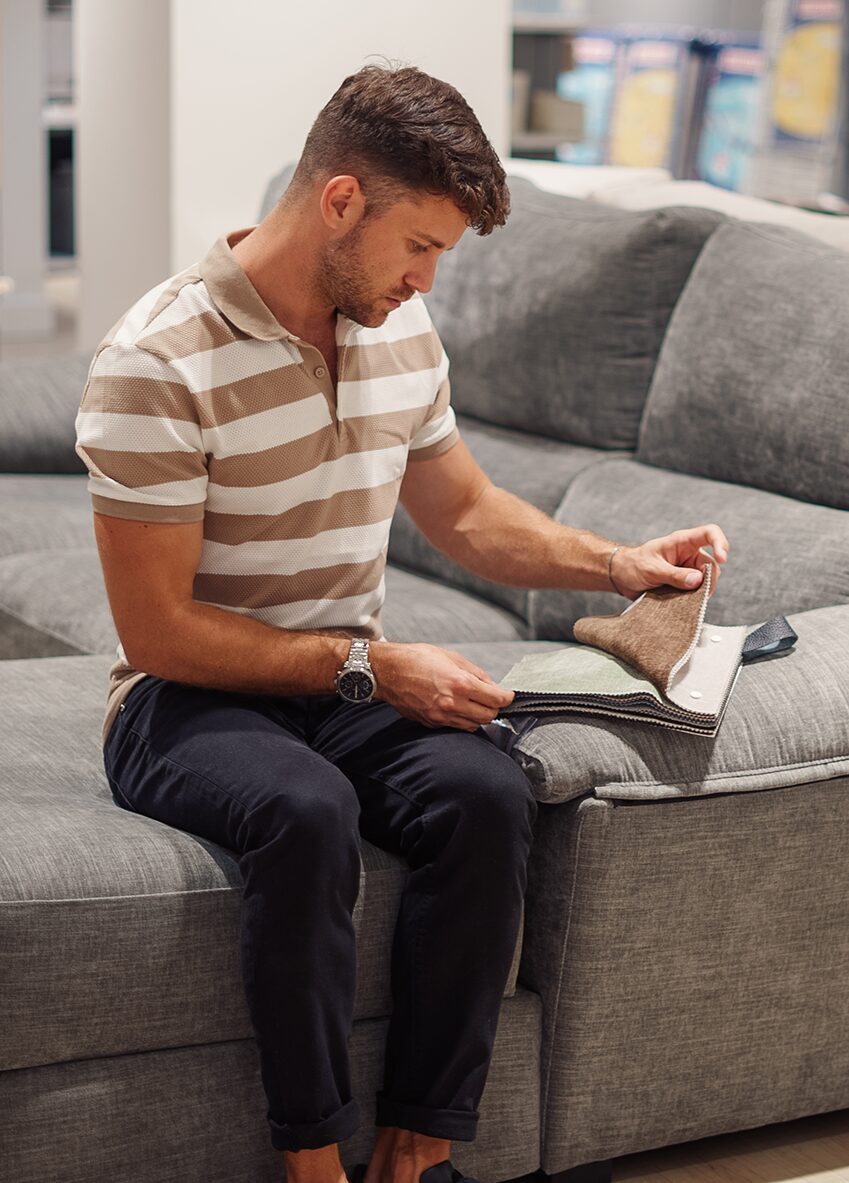 During this week’s Shoptalk event, George Hanson, EVP, Chief Digital Officer at Mattress Firm, shared a profound insight on a panel titled “Setting Store Associates Up for Success Through Tech Enablement.” He revealed that despite 90% of their sales occurring in-store, a staggering 90% of the company’s customer journeys kick off online. This dichotomy underscores a fundamental shift in consumer behavior that furniture retailers are grappling with today.
During this week’s Shoptalk event, George Hanson, EVP, Chief Digital Officer at Mattress Firm, shared a profound insight on a panel titled “Setting Store Associates Up for Success Through Tech Enablement.” He revealed that despite 90% of their sales occurring in-store, a staggering 90% of the company’s customer journeys kick off online. This dichotomy underscores a fundamental shift in consumer behavior that furniture retailers are grappling with today.
Apart from this valuable industry perspective, almost every furniture retailer echoes a shared sentiment: the process of buying furniture has undergone a significant transformation. The traditional distinctions between online and in-store shopping have dissolved, giving rise to an entirely new customer journey. One CEO put it this way, “The website is now the front door to our stores.” Though retailers have observed this shift, it’s been difficult to quantify.
We partnered with Provoke Insights to survey over 400 recent furniture buyers to help retailers better understand the intersection of digital and in-store experiences. The result is the 3D Cloud Furniture Shopping Trends Study 2024, which provides new data and insights into how consumer behavior and expectations during the furniture buying journey have evolved.
3D Cloud Furniture Shopping Trends Study 2024 background and objectives
3D Cloud by Marxent, a company specializing in 3D product visualization platforms, aimed to gain a deeper understanding of various aspects of the customer experience. We collaborated with Provoke Insights to gather valuable new data including:
- Comparing in-store and online retail experiences.
- Identifying challenges related to visualizing custom-made products and room layouts.
- Exploring the role of 3D technology in the furniture buying process.
- Assessing the demand, interest, and user experience with a 3D tool for visualizing room layouts and custom-made furniture options.
3D Cloud Furniture Shopping Trends 2024 methodology
Provoke Insights developed and conducted a 40-question online survey among 400 furniture purchasers. All participants met the following criteria:
- Purchased furniture in the last 6 months
- Has a household income of $50K+
- Ages 25-69
- Lives in the United States
How people shop for furniture
When buying furniture, many start by researching online and then finalize their purchase in a physical store. Visiting stores lets them see, touch, and try out the furniture, which is important to them. This process involves looking through about three websites on average and visiting the same number of stores in person.
- People who only shop online prioritize convenience, options, and price.
- Some start by visiting stores but then buy online for discounts or free shipping.
- Older buyers are more likely to buy exclusively in-store.
The most popular furniture purchases are home decor items and mattresses. Most people browse online stores and also visit physical stores before making a purchase.
When shopping for new furniture, shoppers are most likely to visit a website first, then purchase in a store
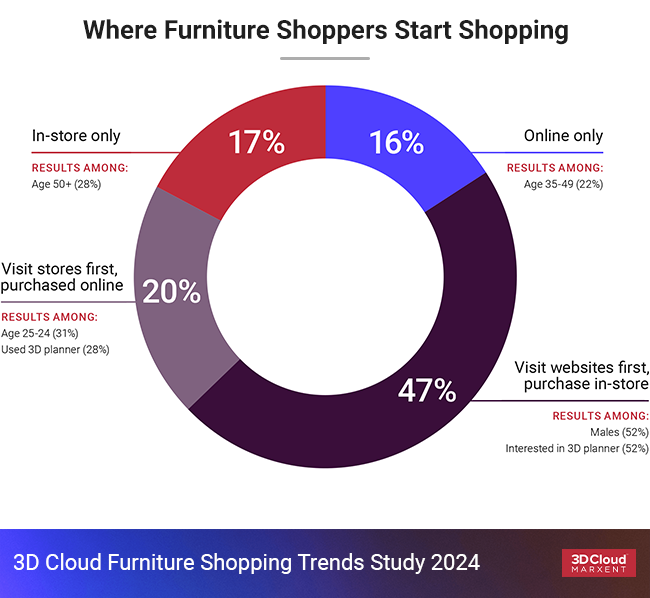
Why people shop for furniture online before going into a store
Here are some reasons why people shop for furniture online before going to a store:
- Research First Online and Confirm Quality In-Person
- “I prefer to view furniture models on the Internet because of their variety, then buy from the store to ensure the quality of the furniture in reality.”
- “I like to research the product online and then see it for myself to assure the product is exactly as described.”
- “I can review to see what interests me and then see firsthand what I viewed.”
- “I get an idea of what I’m looking for and where to find it and then to actually see it in person.”
These quotes capture the essence of how consumers use online platforms to research, explore variety, assess quality descriptions, and narrow down their preferences before making an in-store purchase decision.
Shoppers are most likely to combine in-store and online shopping when buying new furniture
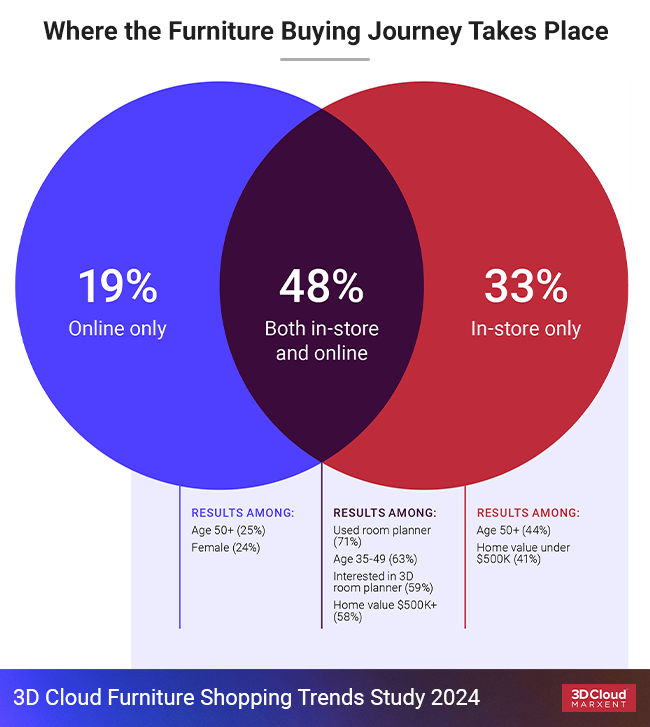
3D makes furniture shopping easier
Customizing furniture, from choosing colors to fabrics, is common. However, half of shoppers struggle to imagine how furniture from a store will fit in their homes. They want more help in-store to visualize this, especially if they live in homes worth $500K+ or are under 50 years old.
In-store assistance usually means a showroom tour only. Only a quarter of shoppers have used 3D visualization software in stores to help them see how furniture would look in their homes.
3D room planner benefits and usage
Most people who had used a 3D room planner tool found it very helpful in deciding which furniture to buy. They said it helped them with measurements and imagining how the furniture would look in a room. They also found the process more enjoyable than past furniture purchases without using the tool.
Most of these users were aged 35-49, shop both online and in-store, and live in homes worth $500K or more. Interest in using a 3D room planner again in the future is high, especially among those who have already used it
There is a high level of interest in 3D room planner experience as a part of free design services offerings.
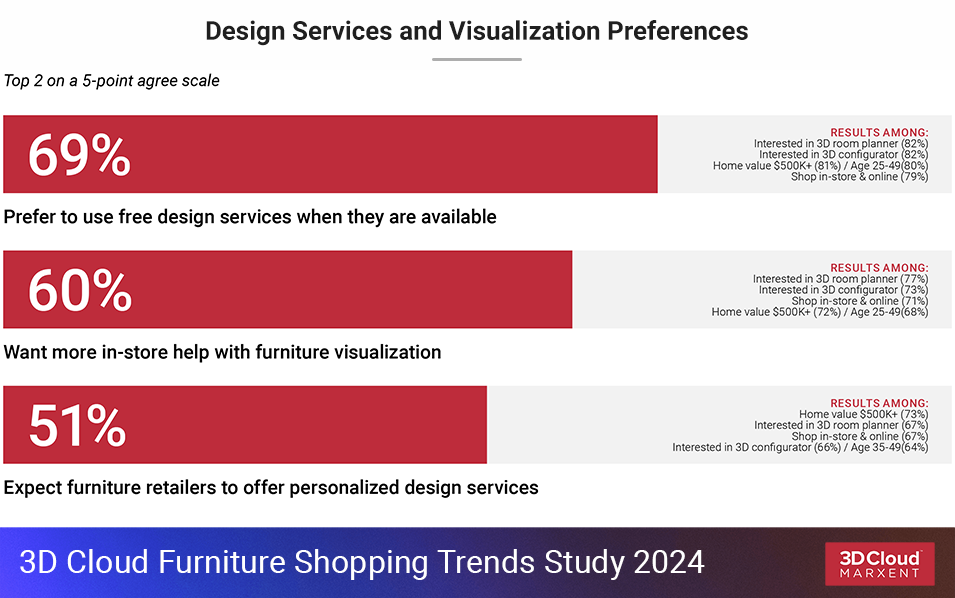
Consumers like that 3D room planners can help them to visualize how furniture will look within their actual floorplan.
- “It helps me see how my furniture will look like in my home.”
- “It helps me to visually imagine how the furniture will look in my home.”
- “It took a little while for me to get the hang of it, but it helped with getting the measurements just right for what I could fit.”
- “I was able to get the right size furniture to fit my space.”
These statements highlight the usefulness of 3D room planners in helping users visualize how furniture will fit and look in their homes, as well as assisting with measurements and size considerations.
3D product configurator benefits and usage
While customizing furniture is common, only a third of people who customized furniture used a 3D configurator. Most commonly they used it through a virtual design service or on a website. Most users found the 3D configurator very helpful. They said it gave them confidence in their furniture-buying decisions.
Nearly two-thirds of furniture shoppers are interested in using a 3D product configurator, especially those who struggle to visualize their furniture purchases.
3D product configuration is becoming increasingly common and is a basic consumer expectation
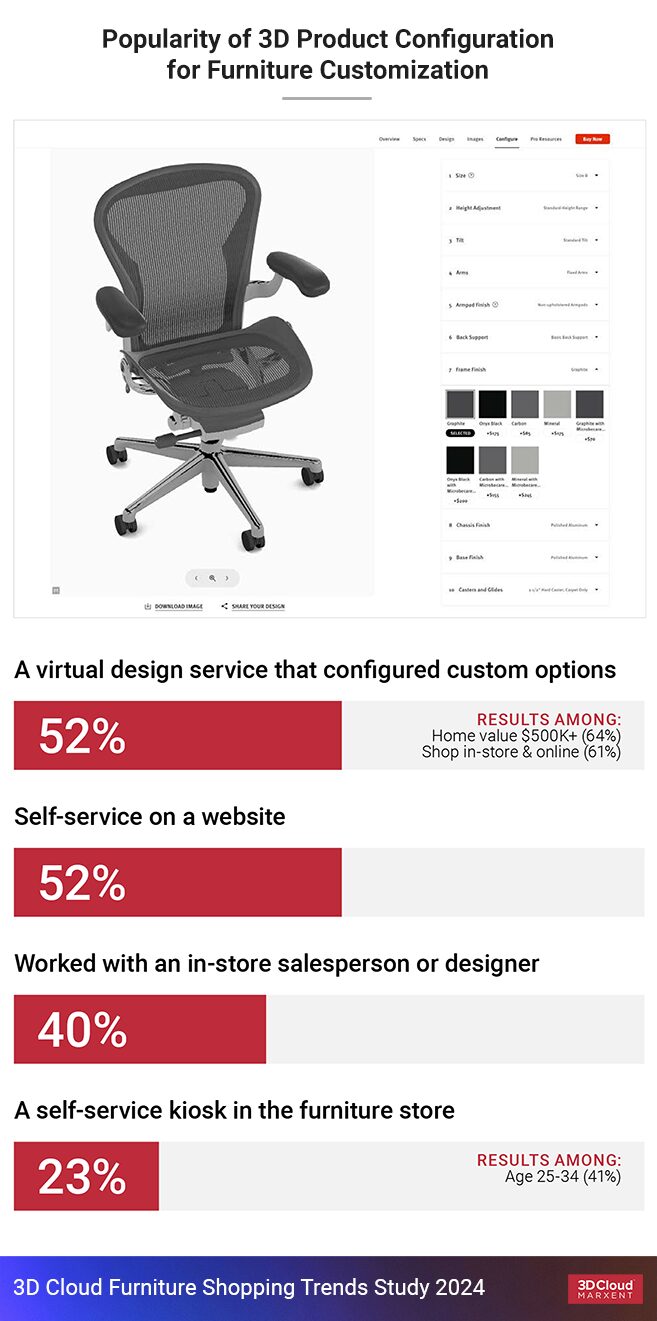
Using 3D room planners and configurators is crucial for furniture stores aiming to enhance customer experiences.
- Two-thirds of those who didn’t use a 3D visualizer or configurator when buying furniture wish they had.
- Almost three-quarters want to use these tools every time they shop for furniture.
- More than three-quarters feel that using 3D visualization or configuration makes them better at buying furniture.
- Two-thirds prefer shopping at retailers that offer these services.
Consumers prefer retailers who offer 3D product configurators
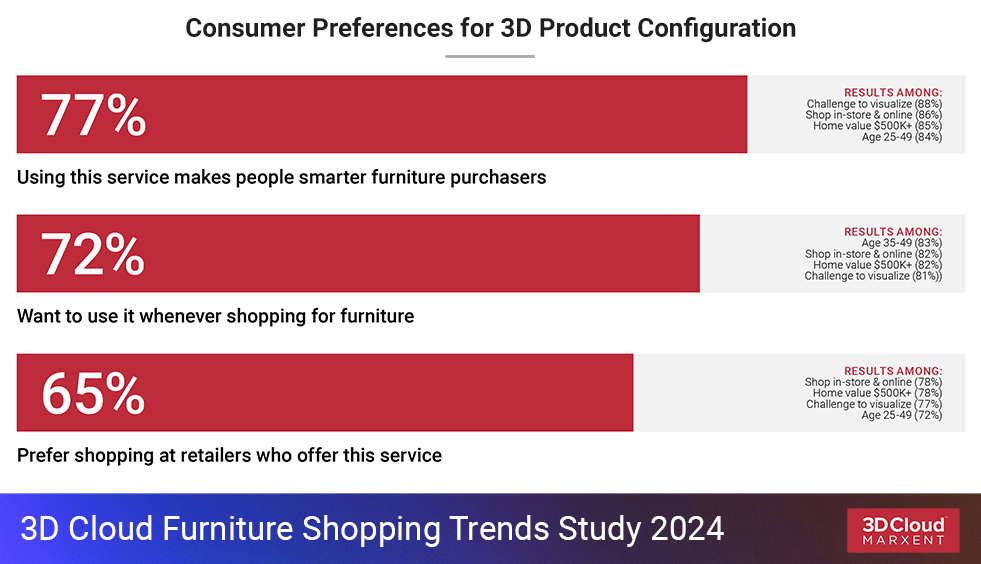
Here are some experiences that highlight how 3D product configurators improve buyer confidence:
- “Helped me to see how the color of fabric and finishes worked together as well as a better idea of how the pattern (size of pattern and repeat) look. On the pattern, the repeat was too big for the size of the ottoman so that was good to eliminate.”
- “It was very cool and let me see what it would look like without actually buying it yet.”
- “Enjoyed this experience. Allowed me to see my favorite colors on the furniture rather than a small square.”
- “Helped me get a better visual on how the final product would look.”
These statements demonstrate how 3D product configurators provide users with a better understanding of color combinations, patterns, and overall visual appearance, ultimately increasing their confidence in their purchase decisions.
3D visualization and the future of furniture shopping
The future of furniture shopping is increasingly tied to 3D visualization and configuration tools:
- 65% of shoppers plan to use 3D tools for a future purchase.
- Among those who didn’t use 3D visualizers or configurators:
- 32% strongly agree and 33% agree that they wish they had used these tools.
- This sentiment is especially strong among those who shop both in-store and online (80%), find it challenging to visualize furniture (75%), are aged 25-49 (73%), and have homes valued at $500K+ (72%).
These findings indicate a growing preference for 3D visualization and configuration tools among furniture shoppers, with many expressing regret for not using them during their previous purchases.
Download the complete 3D Cloud Furniture Shopping Trends 2024 report












